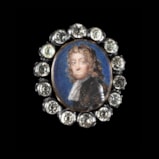SUSANNAH-PENELOPE ROSSE (née GIBSON)
(c.1655-1700)Portrait miniature of a Gentleman, thought to be Edward Montagu, 1st Earl of Sandwich (1625-1672), wearing armour and white lace jabot, his hair worn long and curled
Circa 1674
Watercolour on parchment
Original gold and silver-gilt paste-set enamel clasp (possibly by Michael Rosse, the artist’s husband), the counter enamel with cipher set in decorative black and pink border (some losses to the surround)
Oval, 25 mm (1 inch) high
SOLD
Rosse’s copies of Cooper’s miniatures were praised by George Vertue ‘as by these may bee seen; nobody ever copy’d him better’ (Vertue I, p.116). A talented artist, she did not need to work for a living, but produced portraits of family and friends which serve as an intimate record of her life. Tradition states that this portrait is of Edward Montagu, 1st Earl of Sandwich – an important figure in the navy and a central figure in the diaries of his cousin, Samuel Pepys. If this portrait does represent him, it may be a memorial portrait painted for his wife, who herself died in 1674.[1] The armour worn by the sitter here certainly suggests that he fought during the English Civil War. Many of her connections to artists and sitters came through her parents, who were famous at court not only for their artistic talents but also for their small stature.
The setting of this miniature is a fascinating, and rare, example of seventeenth century enamelwork. Susannah-Penelope was married to Michael Rosse, jeweller to the crown, who presumably provided settings for her portraits. Many of her works are small enough to be worn, and this would have made perfect business sense for the couple to operate in this way. It is not known if Michael Rosse was an enameller, but he may have sought the skills of Northern European watch enamellers to decorate this slide.
Enamel painting was still in relative infancy at this date, with French enamellers migrating (usually for religious reasons) to England and setting up workshops. The invention of a smaller, slimmer pocket watch during the 1660s also meant that the art of enamel decoration was perfectly suited to the scale of a wearable portrait miniature’s locket case.
The two craftsmen of Chateaudun who were fundamental in the development of enamel decoration were the goldsmiths, decorators, and miniature painters Jean Toutin ( 1578-1644 ) and Henri Toutin, his son ( 1614-c. 1683 ). It seems that the technique was taught by the former to the latter, but we assume that there was a parallel development in the workshops of Chateaudun and Blois. This is because the artists who painted on enamel, coating gold objects, were basically goldsmiths, whether they were classified as miniature painters or as watch decorators. Here, the painted enamel decoration over a white ground (which was fired first) occurred after 1630. The gold clasps at the back of the slide allowed the wearer to attach a ribbon and wear the portrait attached to clothing or a wrist.
[1] ‘Slides’ were often commissioned as mourning jewellery at this period - the few which survive are decorated in enamel and without a portrait.
Private Collection, UK.

shipping notice
Worldwide shipping is included in all prices.
The Limner Company does not accept any responsibility for import duty, this is to be paid by the buyer.
Some stock items contain materials from endangered species which are governed by CITES regulations and will require a permit to export outside of Great Britain. If a certificate of export is required then this will be the responsibility of and paid for by the buyer .
you may also like













